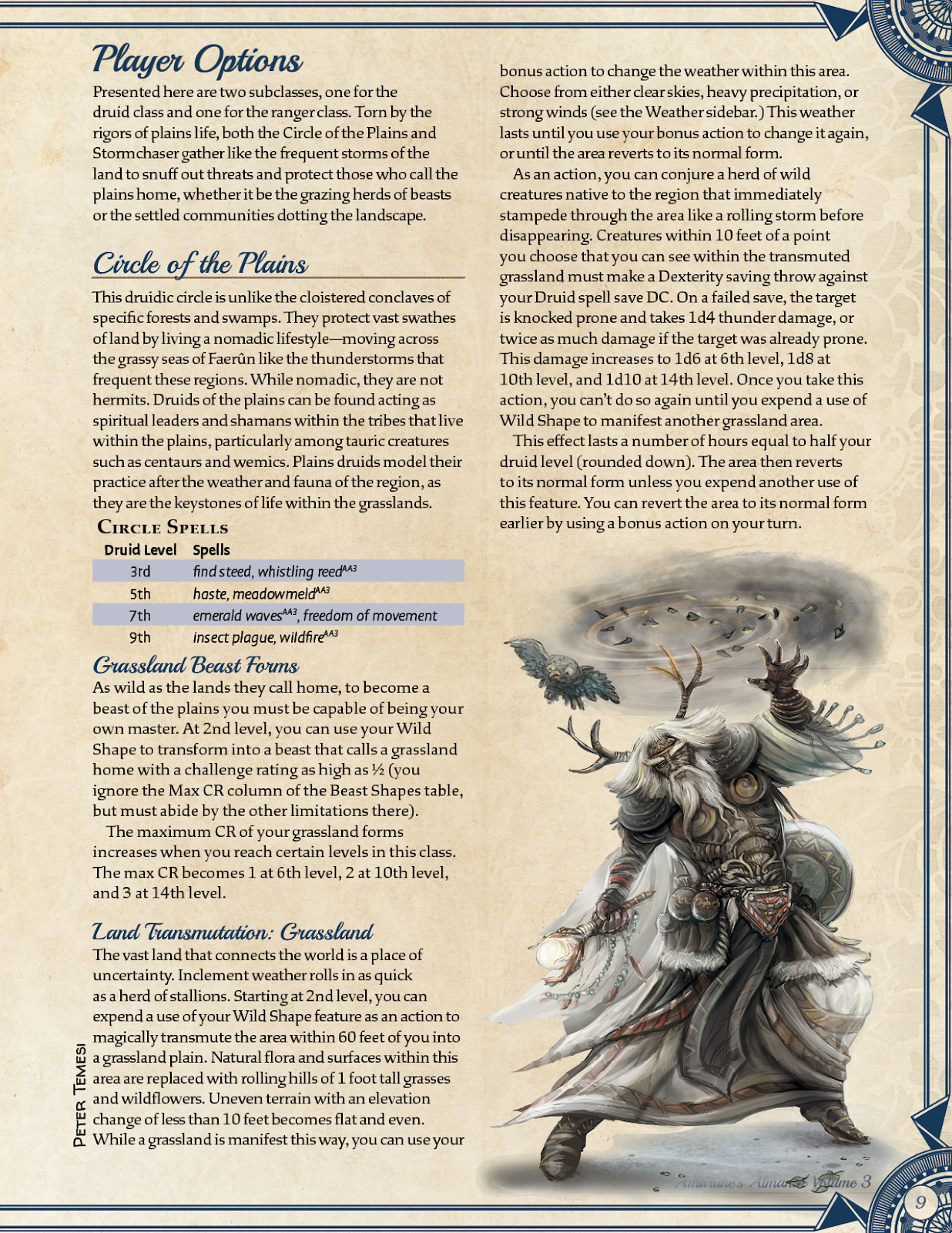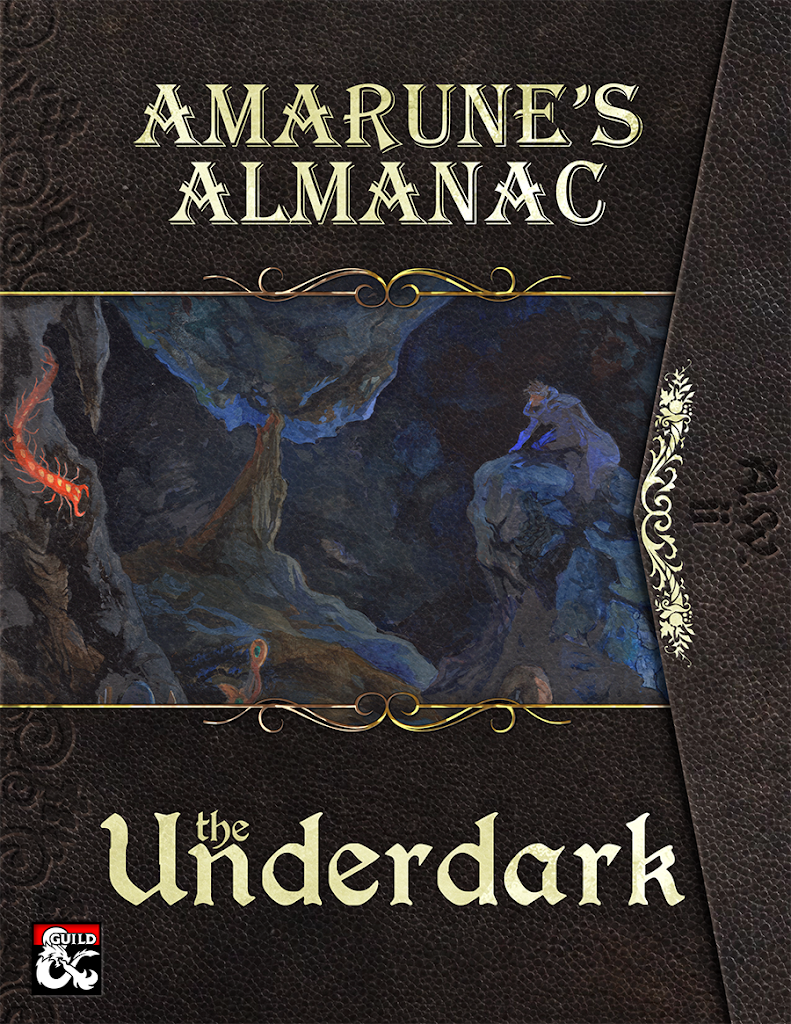It seems like not long ago that I reviewed a then not yet released Amarune’s Almanac Volume 1: Forests of the Realms. Yet here we are again with a double feature review for Volumes 2 and 3, both of which have been released since! I can only assume that the creative team have been working on multiple volumes of Amarune’s Almanac concurrently. If not, that’s one impressive production cycle!
Volume 2 covers the subterranean realm known as the Underdark. It’s not the biome I would have expected to follow forests, necessarily, but it makes sense to get it out of the way early. After all, it’s probably the most important and commonly used biome in the context of adventuring environments.
Volume 3 is all about Grasslands of the Realms: plains, savannas, shrublands, and prairies.
The fact that I’ve already reviewed a book in this series is helpful, as there are naturally many similarities between them. The strengths of the previous product are all here too, and similarly things for which I provided criticism are also reflected in these new products. Lack of change on these is understandable: even if the creative team happen to agree with my feedback, they no doubt feel consistency across the series is important. Anyway, long story short, my thoughts on Volume 1 hold true here as well and you might like to read that review first.
For the remainder of this review, I’m going to shorten the titles of these two books to Underdark and Grasslands, respectively. Likewise, Forests will be shorthand for Forests of the Realms.
 |
 |
| Amarune’s Almanac: The Underdark | Amarune’s Almanac: Grasslands of the Realms |
Value
Like the previous volume, Underdark and Grasslands each cost $9.95. Underdark is 65 pages and Grasslands is 50 pages excluding cover page. Compare to the 48 pages of Forests, which was already great value. These books each feature a similarly wide variety of content: setting lore and locations; archetypes, spells, and other player options; rules for biome-specific flora; creature statblocks; and magic items. Underdark also includes a helpful map of Underdark regions overlaid over the Realms. The production values of the series continues to be very high.
| SCORE OUT OF 4: |
Quality
You can refer to my review of volume 1 for comments on quality. This is a series, after all, so things like design, tone, and the like are consistent. Everything I said before holds true here, as does the previous score.
 |
| Stormchaser Ranger (Amarune’s Almanac: Grasslands of the Realms) |
| SCORE OUT OF 6: |
Content
As was the case with Forests, both of these books have a foreword by Ed Greenwood. He is also credited as a member of the writing team for Volume 3! This is undoubtedly a selling point for many.
The content of the books is naturally similar to Volume 1 in terms of both layout and material. One of the things that surprised me about Volume 1, Forests, was that only 12 pages were given over to introducing the forest biome and describing specific forest locations in the Realms. Underdark gives the same number of pages to describing its biomes and specific locations of note, while Grasslands uses 10 and a half pages for these sections. More space is given over to character options, spells, monsters, magic items, and the series’ signature gathering system. However, the lore that is included is excellent and well-researched.
The following lore sections are included in these books:
- Underdark:
- The introduction. Amarune introduces herself, explains the concept of the Underdark, describes the faerzress (a form of magical radiation), and clarifies that the Underdark itself is broken up into multiple sub-biomes.
- Locations, which includes descriptions of five Underdark regions: Araumycos, the Burgeoning Rift, the Firelands, the Glimmersea, and the Sharn Wall.
- Grasslands:
- The introduction. Amarune introduces herself and explains the various types of grasslands.
- Locations, which includes descriptions of five regions: the Battle of Bones, the Cliffs of Leaping Horses, the Eastern Plains, Mistledale, and the Shining Planes;
 |
| Underdark Map (Amarune’s Almanac: The Underdark) |
As I noted in my review for volume 1, the presentation of the lore sections as in-setting travel writing has its pros and its cons. The descriptions are very evocative and inspiring, but the format makes the book less efficient a reference. As before, I recommend you take some notes of any interesting details you want to use as you read, because it’ll be a lot easier to refer to those notes later in your planning or in play than have to parse each section all over again every time.
Player Options
Underdark and Grasslands both include two new archetypes each, new spells, and repeat some additional rules first seen in Volume 1. These additional rules will presumably be reprinted in all future volumes, and include a variant for the Druid’s Spellcasting and the Ranger’s Natural Explorer.
- The Druid’s Spellcasting variant lets the druid swap a spell they have prepared for an Environment spell that matches the biome the druid is currently within. They may do so once per short rest by spending 1 minute per spell level in meditation. Environment spells are those printed in Amarune’s Almanac (or any other product that adopts the concept) and have an Environment component. Basically, Environment spells can only be cast in particular types of terrain.
- A variant for the Ranger’s Natural Explorer grants the ranger 4 spells appropriate to the ranger’s favoured terrain. Rangers with multiple favoured terrains can swap spell lists every long rest.
These features are of limited use this early in the series, but their usefulness expands with every volume released. Once the series is complete, Druids and Rangers will have options for every environment they might be adventuring in.
 |
| The Sharnbound (Amarune’s Almanac: The Underdark) |
I commented in my previous review that I’d love to see more varied archetypes, rather than merely ticking the Druid and Ranger boxes. It’s to be expected, but in my honest opinion is sometimes redundant. It’s possible to make a druid suited to most if not all biomes already with existing archetypes, for instance. Admittedly, I do understand the desire to write more interesting environment-themed archetypes than the one-size-fits-all Circle of the Land! Still, I’d love to see some biome-themed archetypes for other classes we wouldn’t necessarily expect. If not instead of the Druid and Ranger archetypes, then in addition to! My wish isn’t fulfilled by either of the two new volumes sadly, so I won’t hold high hopes that this pattern will change going forward. But fingers crossed…
Another piece of feedback I gave related to Circle Spells: not all Druid archetypes have the Circle Spells feature, and this is why it’s very important that the archetypes that do offer these spells include the necessary text to explain how they work. Yet none of the druid archetypes in Volumes 1 through 3 of this series do. I repeat this feedback because I genuinely believe it’s a mistake not to correct it. It doesn’t seem like good practice to assume prior knowledge on the part of the player, or to require them to refer to another source (in this case a second, official archetype) in order to play their character.
I’m concerned about this review running over-long, so I’m not going to do a deep analysis on these archetypes as would be my usual habit. Instead, I’ll briefly describe them and summarise my thoughts.
The Circle of the Dark (Underdark)
An Underdark-themed druid circle, a concept which puts this archetype into the same narrative space as the Circle of the Land (Underdark). Circle of the Dark does a pretty solid job of separating itself from the Circle of the Land (Underdark) by focusing primarily on the magical nature of the Underdark. An innate divination magic to sense the location of creatures in darkness, and the ability to channel the magical radiation known as Faerzness is fun and on point. If I could change one feature it would be Fungal Infestation, which is a sudden departure from this archetype’s brand into thematic territory belonging to the Circle of Spores.
Features it has in common with the Circle of the Grove previously published in Forests include more powerful beast forms that are native to the biome, and the ability to transmute the land of their biome. Their Faerzness Surge is kind of like the sorcerer’s Wild Magic table, triggering whenever use you a Wild Shape in the Underdark or to use your Land Transmutation. The major difference is all of the eight effects (rolled on a d8) are essentially helpful power boosts. At 6th level the Circle of the Dark Druid gains an innate location sense for any creature within 60 feet that would normally be concealed by darkness. This presumably also functions in magical darkness as no distinction is made within the text. This feature is implicitly magical (a type of divination to be precise). I divined this (sorry not sorry) from the fact it can be blocked by 1 foot of stone, 1 inch of common metal, a sheet of lead, or 3 feet of wood or dirt. These are the same barriers that block many divination spells.
Sharnbound (Underdark)
I was worried the Ranger archetype would be too similar to the Gloom Stalker, but that was unfounded. Sharnbound sell themselves on concept alone: these Rangers patrol a magical barrier known as the Sharn Wall, erected by the aberrations known as sharn to trap a threat that even they feared: the phaerimm. Sharn are composite being made up from the minds of three or more former humanoids. Sharnbound Rangers bond with a dying sharn’s life force, becoming a symbiotic entity that grows more aberrant as the ranger becomes strong enough to survive the physical changes. A sidebar here provides a table of d10 personalities for the symbiotic Sharn. You roll three times, one each for every mind in the Sharn’s fragmented psyche. Being sharnbound makes you very aberrant: you gain the ability to sprout a black tentacle to make a special grapple, pick up items, or move around the battlefield. The ability to stick to a surface you pull yourself to is incredible tactically, especially for a ranged build. Later, you acquire the ability to become ooze-like and move through tiny gaps and hostile creatures’ spaces. As a matter of personal taste I’d prefer it to cost a bonus action or reaction. Turning from a humanoid to an ooze feels like it would take a couple of seconds as a process, not be complete instantaneously.
The 11th level feature Accelerated Physiology is interesting from a design perspective, because it takes one of the archetype’s bonus spells and turns it into a core part of your gameplay. As an aside, I’ve been experimenting with this sort of thing myself, so I’m excited to see it here! Admittedly, you were probably using haste before. It’s too good for a Ranger not to be in your arsenal. But with Accelerated Physiology, if you cast haste on yourself, you can’t lose concentration from taking damage, and you are immune to the effects that normally apply when haste ends. This feature also lets you spend your reaction after rolling initiative to immediately cast any of your Sharn Magic bonus spells (which, of course, includes haste). All things considered, this is a pretty incredible feature. Whether it’s balanced or not might depend on your campaign’s typical adventuring day. For contrast, at 11th level the Gloom Stalker gets an extra attack every turn (but only if they miss one attack, so note that the maximum possible damage cap isn’t raised). Leaving aside the tactical advantage of casting a spell when initiative is rolled, you’re getting up to 3 minutes (you can cast haste three times) of a bonus attack or other action, +2 AC, advantage on Dexterity and saving throws. It’s very rare for a D&D combat to last over a minute, so think about how many combats you normally run.
This archetype is A+ on theme and fun, but my gut feeling is that it does have the potential to feel overpowered, even if it technically isn’t. See its unparalleled ability to use the environment (hit and run tactics through gaps too small for larger sized enemies, sticking to walls and ceilings to rain death upon monsters with no good ranged options, etc.) and combine with the extra damage potential and defensive boosts of haste. I don’t think it’s breaking anyone’s game as long as the DM takes these abilities into consideration, it’s just something to be aware of. As is the fact that this archetype is oozing (still not sorry) with mechanical potency and fun gameplay to the extent there could be some frustration for other warriors in the group which possess a less exciting suite of options.
 |
| The Circle of the Plains (Amarune’s Almanac: Grasslands) |
The Circle of the Plains (Grasslands)
Like the other two druid circles currently printed in the series, the first level features of this archetype include circle spells, more powerful beast forms, and a land transmutation effect. The archetype’s other features are mostly to do with mobility and maneuvering: Plainswalker grants a bonus action Dash and Pack Ambush lets your allied spend their reaction to Hide when you do, using your own Stealth check. The archetype’s capstone is the ability to whip up a tornado which can pull in creatures, damage them, and eject them in a random direction. Decent battlefield control!
Stormchaser (Grasslands)
This ranger is, well, storm-themed. And it’s pretty damn cool. Its stormwind surge lets you double your speed temporarily until the start of your next turn, and deal increased damage with lightning or thunder for the duration. Later on at 11th level, you’ll eventually pick up what is effectively a compromise between resistance and immunity to those two damage types: while you’re only granted resistance, you can spend your reaction to reduce the damage to 0 and recharge stormwind surge. So if you only take thunder or lightning damage once in a round, and you didn’t spend your reaction on anything else, you’re functionally immune for that round. It’s a pretty neat mechanic, though resistance alone to two damage types is very powerful. The rest could be considered too much. Still, how often are you going to fight a creature that only relies on lightning or thunder damage? It’s probably fine.
The 7th level feature summons a steed of lightning, which is metal as hell. You can also grant your benefits from stormwind surge to your steed, which is a great touch. Your steed is upgraded at 15th level, and you gain the ability to summon a localised lightning storm around the steed.
Spellcasting
Each book has a spellcasting section. In both cases it introduces and explains the concept of an Environment component (this is not new information if you already own volume 1, of course) and each provides 11 new spells across a wide variety of levels. One ritual, Druidic Practice, is reprinted from the first volume. My comments on Druidic Practice can be found in the previous volume’s review.
 |
| Spells (Amarune’s Almanac: The Underdark) |
The spells are fun, flavourful, useful, and seem balanced.
My favourite of the spells in Underdark are morass, which covers surfaces in the area with a white lichen that can restrain and paralyze; as well as delirium, which generates hallucinogenic spores that interact with the game’s optional madness rules. An honourable mention for aphotic armor simply because aphotic is one of my favourite words. I don’t quite know why they appeal to me so much, but my favourite spells in Grasslands are those that make use of grass itself in the casting. blade of grass transforms the grass into a sword, while whistling reed creates a magical grass whistle with a high pitched peal which disrupts hearing and can be used to stun.
Between Adventures
As was the case in Forests, this section of both books includes the rules for the Gathering Plants Expedition downtime activity. To accompany this new activity, both books include 20 flora which includes flowers, fruits, and trees useful for lumber. Descriptions and special rules relating to these flora are included, and tables provide an at-a-glance indicator of where in the Realms each plant might be found, as well as its sale value. These sections are among my favourite parts of Amarune’s Almanac series, providing an easy reference for much needed variety in plant growths with which you can populate the fantastic landscapes of your adventures.
 |
| Flora (Amarune’s Almanac: Grasslands) |
Appendix
Each book includes an appendix which is split into two sections: Beasts and Monsters, and Magic Items.
Beasts and Monsters
This section of Underdark includes 23 new statblocks, associated with a variety of different creature types. This index fills out some iconic Realmsian monster-shaped gaps in the official bestiaries. The descriptions of many monsters in these bestiaries include notes on what resources might be harvested from their corpses. In terms of new beast forms for wild shape, Grasslands is more fertile than Underdark. On the other hand, the larger bestiary of Underdark and its selection of monsters is bound to please any DM. Either way, these sections both excited me a bit more than their equivalent in the first volume.
Both books provide a table which shows precisely which regions of the Realms or Underdark each monster is most likely to be found in.
New monsters in Underdark include:
- The CR 10 angler worm (a relative of the purple worm that lures curious prey to their dangling light)
- The CR 1 azmyth (a variety of strange snake-like bat with the magical abilities to become invisible and discharge lightning)
- The CR 1 blasting jelly (an artificial duergar-made slime with explosive properties)
- the CR 5 swarm of bloodbites (quipper-like fish that swarm through the air of the underdark, rather than water)
- The CR 1 cavvekan (bat-like dogs that Underdark species use as hunting animals)
- The CR 4 wyrmling, CR 10 young, CR 17 adult, and CR 24 ancient deep dragon (a burrowing dragon with a dazing brath and the ability to polymorph into snake and humanoid forms)
- The CR 16 drowbane (a predatory aberration that hunts by sonar)
- The CR 1 fire bat (a bat… that’s on fire)
- The CR 8 ghaunadan (an ooze servant of the god of abominations, which can shapechange into the form of a drow to walk unnoticed among them)
- The CR 2 knell beetle drone and CR 4 knell beetle (a giant bug with a strange sonic trumpet it can use to blast foes with thunderous noise)
- The CR 6 lith (a form of psionically crafted earth elemental)
- The CR 4 juvenile, CR 9 young, CR 13 adult, and CR 19 elder phaerimm (a race of worm-like aberration sorcerers that can eat magic energy)
- The CR 1/4 rockmite and CR 2 swarm of rockmites (silverfish-like giant bugs that can burrow through solid stone)
- The CR 10 sharn (aberrations born from chaos magic and fragmented minds)
- The CR 1/2 spore weaver (a variety of spider which have a symbiotic relationship with fungal growths on their bodies
New monsters in Grasslands include:
- The CR 2 bison and CR 6 primeval bison (the latter of which is a huge variety that is imbued by primal magic)
- The CR 1/8 flower blight (a new type of good-aligned blight)
- The CR 3 huuserpent (giant two-headed constrictor snakes)
- The CR 3 jaskar (a large variety of vulture, capable of picking up humanoids and dropping them to their deaths)
- The CR 18 living tornado (a massive air elemental of evil intent)
- The CR 2 pink zebra (a fey trickster that enjoys harassing mortals – but none so much as a mortal that threatens their herd)
- The CR 4 razor bulette (a variety of bulette with chitinous blades and wicked bite)
- The CR 2 herbivorous and CR 2 carnivorous scathebeast (strange many-eyed herd beasts with an ability to adapt to resist damage taken)
- The CR 2 wermic warrior, CR 3 wermic hunter, and CR 6 wermic shaman (a race of lion-centaurs)
- The CR 2 zhuruda (magical flightless birds with innate spellcasting that varies based on the colour of their plumage)
Magic Items
Underdark contains 11 magic items, and Grasslands has 10. This section was one of my favourites in Forests, and the same is true of these volumes: each is an excellent collection of fun items to add to your game. A particular favourite from Underdark is Maggris’ Bracelet of Summoning, which has a lot of creep factor thanks to its effect of drawing insects and bugs to you, which you can cause to swarm enemies. It also lets you summon giant insects and beetle swarms which you can control. my favourite from Grasslands is probably the Skull of the Stampede, a helmet made from a bison skull which gives you a powerful charge-like stampede ability.
Organisation
| SCORE OUT OF 10: |
Final Thoughts and Rating
Everything that was good about volume 1 remains true, but on the other hand so do the things I considered less positive. Thankfully, those are a pretty minor factor compared to the overall quality of these products. Constructive criticisms and quibbles aside, Amarune’s Almanac has shown a consistent excellence in game and graphic design, writing, and illustration. If anything, these two volumes slightly raise the bar with bestiaries that were – to me – far more interesting. All things considered, what you get in each volume is an absolute bargain at the price.








